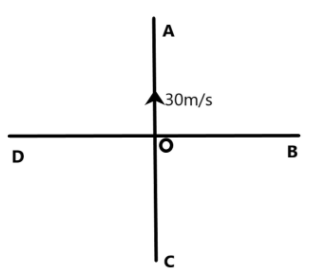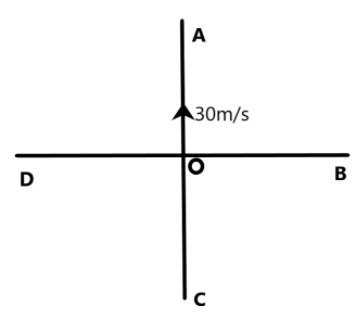Answer
405.3k+ views
Hint: We need to determine the variation of frequency with respect to the observers in a system. We know that the Doppler’s effect deals with the frequency variation in sound waves due to the relative velocity between the source and the listener.
Complete answer:
The Doppler’s effect for longitudinal waves such as sound deals with the fact that relative velocities between the source and the listener, in case of sound, can cause the listener to experience a change in the frequency of the sound from the source. According to Doppler effect,
\[{{f}_{new}}=f\dfrac{v+{{v}_{listener}}}{v+{{v}_{source}}}\]
Where, v is the speed of sound in the medium and f is the actual frequency of the source.
In our situation, we are given that there are four listeners for a single source of sound which is moving in a particular direction with a relative velocity to each of them. The relative velocities will result in different results for the different listeners.

Let us consider each of the listeners at the time, \[t=0\].
The Source O is moving towards the listener A with a velocity 30\[m{{s}^{-1}}\]. The source is approaching the stationary listener. The frequency as heard by A is given as –
\[\begin{align}
& {{f}_{A}}=f\dfrac{v+{{v}_{A}}}{v+{{v}_{O}}} \\
& \text{but,} \\
& {{v}_{A}}=0,{{v}_{O}}=-30m{{s}^{-1}},f=300Hz,v=330m{{s}^{-1}} \\
& \Rightarrow {{f}_{A}}=300\dfrac{330+0}{330-30} \\
& \therefore {{f}_{A}}=330Hz \\
\end{align}\]
Similarly, we can find the frequency at C as follows –
\[\begin{align}
& {{f}_{C}}=f\dfrac{v+{{v}_{C}}}{v+{{v}_{O}}} \\
& \text{but,} \\
& {{v}_{C}}=0,{{v}_{O}}=+30m{{s}^{-1}},f=300Hz,v=330m{{s}^{-1}} \\
& \Rightarrow {{f}_{C}}=300\dfrac{330+0}{330+30} \\
& \therefore {{f}_{C}}=275Hz \\
\end{align}\]
Now, we can consider the points B and D, these points do not have a longitudinal relation with the sound source. The sound source is moving perpendicular to their direction. Therefore, there experiences no change in the frequency by the listeners at B and D. So,
\[\begin{align}
& {{f}_{B}}=f\dfrac{v+{{v}_{B}}}{v+{{v}_{O}}} \\
& \text{but,} \\
& {{v}_{B}}=0,{{v}_{O}}=0,f=300Hz,v=330m{{s}^{-1}} \\
& \Rightarrow {{f}_{B}}={{f}_{D}}=300\dfrac{330+0}{330+0} \\
& \therefore {{f}_{B}}={{f}_{D}}=300Hz \\
\end{align}\]
The frequencies heard by A, B, C and D are 330Hz, 300Hz, 275Hz and 300Hz respectively.
The correct answer is option D.
Note:
The longitudinal waves do not experience a Doppler’s change when the propagation of the wave is in direction perpendicular to the listener. Other waves such as the light waves experience Doppler’s effect along perpendicular direction also.
Complete answer:
The Doppler’s effect for longitudinal waves such as sound deals with the fact that relative velocities between the source and the listener, in case of sound, can cause the listener to experience a change in the frequency of the sound from the source. According to Doppler effect,
\[{{f}_{new}}=f\dfrac{v+{{v}_{listener}}}{v+{{v}_{source}}}\]
Where, v is the speed of sound in the medium and f is the actual frequency of the source.
In our situation, we are given that there are four listeners for a single source of sound which is moving in a particular direction with a relative velocity to each of them. The relative velocities will result in different results for the different listeners.

Let us consider each of the listeners at the time, \[t=0\].
The Source O is moving towards the listener A with a velocity 30\[m{{s}^{-1}}\]. The source is approaching the stationary listener. The frequency as heard by A is given as –
\[\begin{align}
& {{f}_{A}}=f\dfrac{v+{{v}_{A}}}{v+{{v}_{O}}} \\
& \text{but,} \\
& {{v}_{A}}=0,{{v}_{O}}=-30m{{s}^{-1}},f=300Hz,v=330m{{s}^{-1}} \\
& \Rightarrow {{f}_{A}}=300\dfrac{330+0}{330-30} \\
& \therefore {{f}_{A}}=330Hz \\
\end{align}\]
Similarly, we can find the frequency at C as follows –
\[\begin{align}
& {{f}_{C}}=f\dfrac{v+{{v}_{C}}}{v+{{v}_{O}}} \\
& \text{but,} \\
& {{v}_{C}}=0,{{v}_{O}}=+30m{{s}^{-1}},f=300Hz,v=330m{{s}^{-1}} \\
& \Rightarrow {{f}_{C}}=300\dfrac{330+0}{330+30} \\
& \therefore {{f}_{C}}=275Hz \\
\end{align}\]
Now, we can consider the points B and D, these points do not have a longitudinal relation with the sound source. The sound source is moving perpendicular to their direction. Therefore, there experiences no change in the frequency by the listeners at B and D. So,
\[\begin{align}
& {{f}_{B}}=f\dfrac{v+{{v}_{B}}}{v+{{v}_{O}}} \\
& \text{but,} \\
& {{v}_{B}}=0,{{v}_{O}}=0,f=300Hz,v=330m{{s}^{-1}} \\
& \Rightarrow {{f}_{B}}={{f}_{D}}=300\dfrac{330+0}{330+0} \\
& \therefore {{f}_{B}}={{f}_{D}}=300Hz \\
\end{align}\]
The frequencies heard by A, B, C and D are 330Hz, 300Hz, 275Hz and 300Hz respectively.
The correct answer is option D.
Note:
The longitudinal waves do not experience a Doppler’s change when the propagation of the wave is in direction perpendicular to the listener. Other waves such as the light waves experience Doppler’s effect along perpendicular direction also.
Recently Updated Pages
How many sigma and pi bonds are present in HCequiv class 11 chemistry CBSE

Why Are Noble Gases NonReactive class 11 chemistry CBSE

Let X and Y be the sets of all positive divisors of class 11 maths CBSE

Let x and y be 2 real numbers which satisfy the equations class 11 maths CBSE

Let x 4log 2sqrt 9k 1 + 7 and y dfrac132log 2sqrt5 class 11 maths CBSE

Let x22ax+b20 and x22bx+a20 be two equations Then the class 11 maths CBSE

Trending doubts
Fill the blanks with the suitable prepositions 1 The class 9 english CBSE

At which age domestication of animals started A Neolithic class 11 social science CBSE

Which are the Top 10 Largest Countries of the World?

Give 10 examples for herbs , shrubs , climbers , creepers

Difference between Prokaryotic cell and Eukaryotic class 11 biology CBSE

Difference Between Plant Cell and Animal Cell

Write a letter to the principal requesting him to grant class 10 english CBSE

Change the following sentences into negative and interrogative class 10 english CBSE

Fill in the blanks A 1 lakh ten thousand B 1 million class 9 maths CBSE




